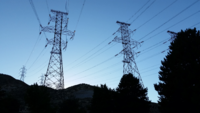
Photo from wikipedia
Electrolyzers are now capable of reducing carbon dioxide (CO2) into products at high reaction rates but are often characterized by low energy efficiencies and low CO2 utilization efficiencies. We report… Click to show full abstract
Electrolyzers are now capable of reducing carbon dioxide (CO2) into products at high reaction rates but are often characterized by low energy efficiencies and low CO2 utilization efficiencies. We report here an electrolyzer that reduces 3.0 M KHCO3(aq) into CO(g) at a high rate (partial current density for CO of 220 mA cm–2) and a CO2 utilization efficiency of 40%, at a voltage of merely 2.3 V. These results were made possible by using: (i) a reactive carbon solution enriched in KHCO3 as the feedstock instead of gaseous CO2; (ii) a cation exchange membrane instead of an anion exchange membrane, which is common to the field; and (iii) the hydrogen oxidation reaction (HOR) at the anode instead of the oxygen evolution reaction (OER). The voltage reported here is the lowest reported for any CO2 to CO electrolyzer that operates at high current densities (i.e., a partial current density for CO greater than 200 mA cm–2) with a CO2 utilization efficiency of greater than 20%. This study highlights how the choice of feedstock, membrane, and anode chemistries affects the rate and efficiency at which CO2 is converted into products.
Journal Title: ACS Central Science
Year Published: 2022
Link to full text (if available)
Share on Social Media: Sign Up to like & get
recommendations!